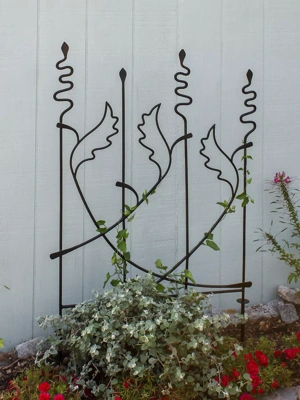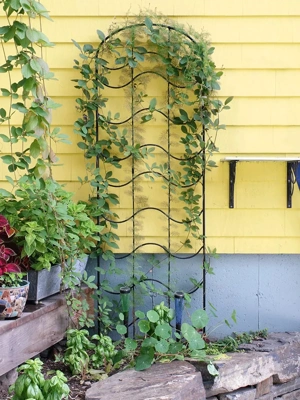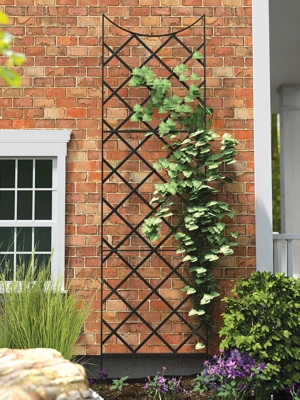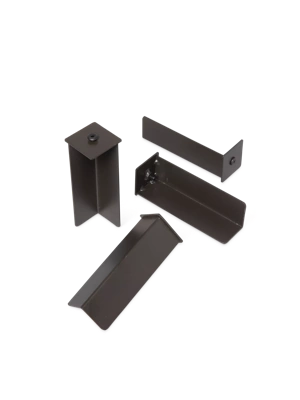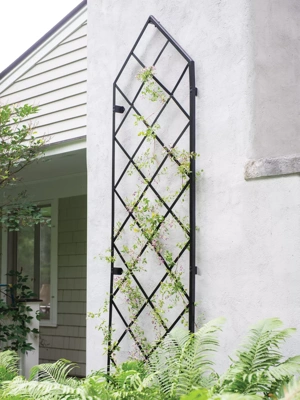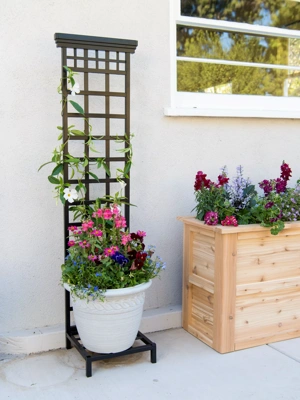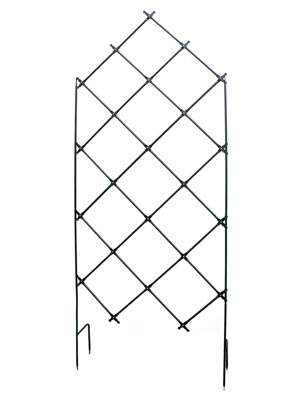How Plants Climb
All about vines and other climbing plants
 Cucumbers, squash, and melons use tendrils to climb.
Cucumbers, squash, and melons use tendrils to climb. Thunbergias (black-eyed susan vine) climb with twining stems. Shop for Flower Trellises.
Thunbergias (black-eyed susan vine) climb with twining stems. Shop for Flower Trellises.Growing up rather than out is a good way to save space in the garden. You also get to enjoy lots of great vine plants such as sugar snap peas, pole beans, moonflowers, bougainvillea, and clematis. Adding a trellis or some other vertical structure to your garden also gives you a whole new dimension of visual interest.
But figuring out how to match climbing plants with the right kind of support leaves many gardeners baffled. Why won't pole beans and tomatoes climb up a lattice frame? Why won't sweet peas and clematis climb a pole?
The answer is that climbing plants climb in particular ways: some wrap, some adhere, and some curl. Here's how to recognize which plants do what:
How Plants Climb: Tendrils
Peas are a good example of a plant that uses tendrils to climb. Tendrils are skinny, wiry structures along the plant's stem that actually reach around in the air until they come into contact with something they can grab. Once contact is made, the tendril curls, forming a coil that allows the plant to adjust the degree of tension or pull on the support.
There are two kinds of tendrils. Stem tendrils (which passionflowers and grapes have) are shoots that grow out of the stem. Leaf tendrils (which peas have) look very similar, but the tendrils are actually modified leaves that emerge from a leaf node.
Like a rock climber scaling the face of a mountain, plants that have tendrils need handholds in the form of horizontal supports. Netting works well for plants with tendrils, as long as the mesh is more than 2" square. I once tried growing sweet peas on some bird netting that we had lying around and the peas refused to take hold.
Branches are a popular material for supporting tendril-climbers. Just make sure that branches are brushy—with lots of small side shoots—and not smooth, vertical sticks. Horizontal strings attached to posts or bamboo poles are ideal. Just don't position the strings more than about 4 inches apart or the newest set of tendrils may not be able to reach the next level of string. Also, because most tendrils are only about an inch long, they need to wrap around something thin (like string or wire) that's no more than about 1/4 inch in diameter.
Examples of Plants that Climb with Tendrils
Stem tendrils:
- Passionflower (Passiflora)
- Grape (Vitis)
- Ampelopsis glandulosa
Leaf tendrils:
- Sweet peas (Lathyrus)
- Cobaea scandens
- Chilean glory flower (Eccremocarpus scaber)
 Clematis leaf tendrils climbing a support
Clematis leaf tendrils climbing a supportHow Plants Climb: Twiners
Morning glories, pole beans, honeysuckle and clematis are some of the many plants that twine. There are two important differences among twining plants: they either have twining leaves or twining stems.
Plants with twining leaves, such as clematis, use their leaves like tendrils. The young leaves of these plants are able to twist around slender wires, string, twigs or other leaves. The key is to provide a thin enough support for the leaf stem to curl around. A lattice made of 1-inch wide slats won't work for leaf twiners.
Twining stems twist around whatever they touch, be it a pole, branch, wire or chair leg. The stems will wind clockwise or counterclockwise, depending on the species of plant.
There are loosely twining stems such as gourds, and strongly twining stems such as thunbergia, wisteria, morning glory, jasmine and Dutchman's pipe. Some of these twining vines can grow very large and become extremely heavy. Wisteria is famous for pulling down porches and garden structures. If you are planting a perennial vine that will eventually become very large, be sure to provide strong support.
Examples of Twining Plants
Twining leaves:
- Clematis
- Climbing nasturtium (Tropaeolum polyphyllum)
- Rhodochiton
 Morning glories wind their stems around a support.
Morning glories wind their stems around a support.Twining stems:
- Pole beans
- Dutchman's pipe (Aristolochia)
- Bittersweet (Celastrus scandens)
- Morning glory
- Moonflower (Ipomoea)
- Jasmine (Jasminum)
- Honeysuckle (Lonicera)
- Black-eyed Susan vine (Thunbergia)
- Wisteria
How Plants Climb: Scramblers
Bougainvillea and climbing or rambling roses are two of the many plants that fall into the scramblers category. These plants have long, flexible stems that may look like vines, but they are unable to climb on their own. Scramblers sometimes have thorns that help them grip neighboring stems, if you want these plants to "climb" up a trellis, arbor, or pergola, you will need to tack them into place and probably tie them with wire or sturdy string.
Examples of Plants that Scramble or Ramble
- Bougainvillea
- Cape leadwort (Plumbago)
- Climbing rose (Rosa)
How Plants Climb: Adhesive pads
Boston ivy (Parthenosissus tricuspidata) and Virginia creeper (P. quinquefolia) have stem tendrils with touch-sensitive adhesive pads that allow them to stick to almost any surface. Climbers with adhesive pads can attach themselves to the face of a building or the trunk of a tree. If not provided with a vertical support, they will just as happily crawl sideways, attaching themselves to anything in their path.
Examples of Plants that Climb with Adhesive Pads
- Cissus
- Boston ivy (Parthenocissus)
How Plants Climb: Clinging Stem Roots
The last group of climbers use clinging stem roots to attach themselves. The stems of these plants produce a cluster of short, stout roots that cling to surfaces of almost any kind. Examples of plants with clinging stem roots include climbing hydrangea (Hydrangea petiolaris), most ivies such as English ivy (Hedera helix) and Irish ivy (Hedera hibernica), and also euonymus. These plants can damage paint work and mortar if you try to remove the stem roots from a structure.
Examples of Plants that Climb with Clinging Stem Roots
- Euonymus
- English ivy (Hedera)
- Climbing hydrangea (Hydrangea petiolaris)
Last updated: 09/14/2023
Print this Article:
Related items
Get the Dirt
Stay up to date on new articles and advice. Please fill out the information below.

